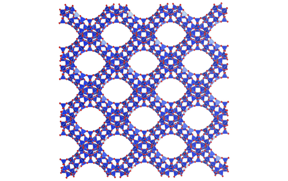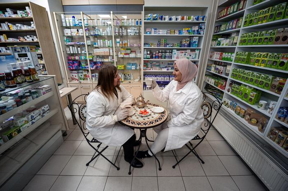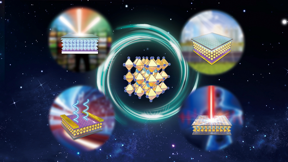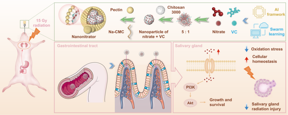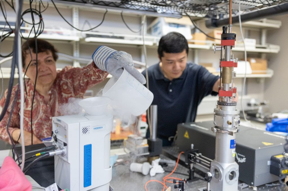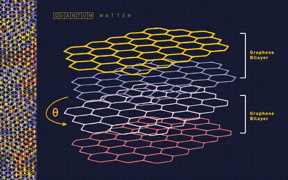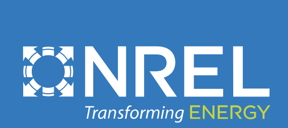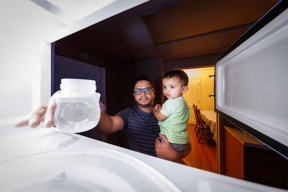Home > Press > University of Toronto researchers discover new lipid nanoparticle that shows muscle-specific mRNA delivery, reduces off-target effects: Study findings make significant contribution to generating tissue-specific ionizable lipids and prompts rethinking of mRNA vaccine design princi
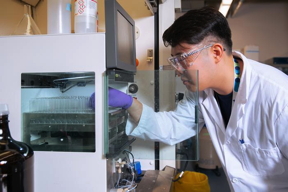 |
| A team of researchers based at the University of Toronto’s (U of T) Leslie Dan Faculty of Pharmacy has discovered a novel ionizable lipid nanoparticle, iso-A11B5C1, that enables muscle-focused mRNA delivery while minimizing off-target delivery to other tissues. CREDIT Steve Southon, University of Toronto |
Abstract:
A team of researchers based at the University of Toronto’s (U of T) Leslie Dan Faculty of Pharmacy has discovered a novel ionizable lipid nanoparticle that enables muscle-focused mRNA delivery while minimizing off-target delivery to other tissues. The team also showed that mRNA delivered by the lipid nanoparticles investigated in their study triggered potent cellular-level immune responses as a proof-of-concept melanoma cancer vaccine.
University of Toronto researchers discover new lipid nanoparticle that shows muscle-specific mRNA delivery, reduces off-target effects: Study findings make significant contribution to generating tissue-specific ionizable lipids and prompts rethinking of mRNA vaccine design princi
Toronto, Canada | Posted on December 8th, 2023The study, led by Bowen Li, assistant professor, Leslie Dan Faculty of Pharmacy, U of T, was published this week in Proceedings of the National Academy of Sciences (PNAS).
Called iso-A11B5C1, the new lipid nanoparticle demonstrates exceptional mRNA delivery efficiency in muscle tissues while also minimizing unintended mRNA translation in organs such as the liver and spleen. Additionally, study results show that intramuscular administration of mRNA formulated with this nanoparticle caused potent cellular immune responses, even with limited expression observed in lymph nodes.
“Our study showcases for the first time that mRNA lipid nanoparticles can still effectively stimulate a cellular immune response and produce robust anti-tumor effects, even without direct targeting or transfecting lymph nodes,” said Li. “This finding challenges conventional understandings and suggests that high transfection efficiency in immune cells may not be the only path to developing effective mRNA vaccines for cancer.”
Reducing off-target effects important step to increase safety of potential therapies
Lipid nanoparticles, also called LNPs, are crucial for delivering mRNA-based therapies including COVID-19 mRNA vaccines that were used worldwide during the recent global pandemic. However, many LNP designs can inadvertently result in substantial mRNA expression in off-target tissues and organs like the liver or heart, resulting in often treatable but unwanted side-effects. The drive to improve the safety of mRNA therapies that have the potential to treat a broad range of diseases means there is an urgent need for LNPs designed to minimize these off-target effects, explains Li who is also a recent recipient of the Gairdner Early Career Investigator Award.
The new research shows that, compared to the current benchmark LNP developed by the Massachusetts-based biotechnology company Moderna, iso-A11B5C1 demonstrated a high level of muscle-specific mRNA delivery efficiency. It also triggered a different kind of immune response than what is seen in vaccines used to treat infectious diseases. “Interestingly, iso-A11B5C1 triggered a lower humoral immune response, typically central to current antibody-focused vaccines, but still elicited a comparable cellular immune response. This finding led our team to further explore this as a potential cancer vaccine candidate in a melanoma model, where cellular immunity plays a pivotal role,” said Li.
The interdisciplinary research team that conducted the study includes Jingan Chen, a PhD trainee from the Institute of Biomedical Engineering at U of T, and Yue Xu, a postdoctoral researcher in the Li lab and a research fellow with PRiME, U of T’s cross-institutional precision medicine initiative. “Although iso-A11B5C1 showed limited capacity to trigger humoral immunity, it effectively initiated cellular immune responses through intramuscular injection,” said Chen. “The substantial anti-tumor effects observed with iso-A11B5C1 underscore its promise as a viable candidate for cancer vaccine development.”
New platform allows for faster, more precise lipid design
The research team identified iso-A11B5C1 by using an advanced platform developed to quickly create a range of chemically diverse lipids for further testing. This platform, newly introduced as part of the study, overcomes several challenges seen in previous research by streamlining the process of creating ionizable lipids that have a high potential to be translated into therapies. By rapidly combining three different functional groups, hundreds to thousands of chemically diverse ionizable lipids can be synthesized within 12 hours. “Here we report a powerful strategy to synthesize ionizable liquids in a one-step chemical reaction,” said Xu. “This platform provides new insights that could help guide lipid design and evaluation processes going forward and allows the field to tackle challenges in RNA delivery with a new level of speed, precision and insight.”
####
About University of Toronto - Leslie Dan Faculty of Pharmacy
The Leslie Dan Faculty of Pharmacy at the University of Toronto is Canada's top-ranked faculty of pharmacy, offering cutting-edge undergraduate and graduate programs. We are globally recognized for impactful pharmaceutical sciences research and fostering expert and innovative clinical practice. Our scientific research focuses on the role of pharmacists in the health care system, and the full scope of drug discovery and delivery. We advance education programs that develop leaders in science and clinical practice and work to strengthen the link between research, education, and patient car
For more information, please click here
Contacts:
Media Contact
Kate Richards
University of Toronto - Leslie Dan Faculty of Pharmacy
Office: 416-206 0310
Expert Contact
Bowen
Li
@uoftpharmacy
Copyright © University of Toronto - Leslie Dan Faculty of Pharmacy
If you have a comment, please Contact us.Issuers of news releases, not 7th Wave, Inc. or Nanotechnology Now, are solely responsible for the accuracy of the content.
| Related Links |
| Related News Press |
News and information
![]() World’s first logical quantum processor: Key step toward reliable quantum computing December 8th, 2023
World’s first logical quantum processor: Key step toward reliable quantum computing December 8th, 2023
![]() VUB team develops breakthrough nanobody technology against liver inflammation December 8th, 2023
VUB team develops breakthrough nanobody technology against liver inflammation December 8th, 2023
![]() Finding the most heat-resistant substances ever made: UVA Engineering secures DOD MURI award to advance high-temperature materials December 8th, 2023
Finding the most heat-resistant substances ever made: UVA Engineering secures DOD MURI award to advance high-temperature materials December 8th, 2023
Cancer
![]() Super-efficient laser light-induced detection of cancer cell-derived nanoparticles: Skipping ultracentrifugation, detection time reduced from hours to minutes! October 6th, 2023
Super-efficient laser light-induced detection of cancer cell-derived nanoparticles: Skipping ultracentrifugation, detection time reduced from hours to minutes! October 6th, 2023
![]() The medicine of the future could be artificial life forms October 6th, 2023
The medicine of the future could be artificial life forms October 6th, 2023
![]() New compound unleashes the immune system on metastases September 8th, 2023
New compound unleashes the immune system on metastases September 8th, 2023
Possible Futures
![]() World’s first logical quantum processor: Key step toward reliable quantum computing December 8th, 2023
World’s first logical quantum processor: Key step toward reliable quantum computing December 8th, 2023
![]() VUB team develops breakthrough nanobody technology against liver inflammation December 8th, 2023
VUB team develops breakthrough nanobody technology against liver inflammation December 8th, 2023
![]() Finding the most heat-resistant substances ever made: UVA Engineering secures DOD MURI award to advance high-temperature materials December 8th, 2023
Finding the most heat-resistant substances ever made: UVA Engineering secures DOD MURI award to advance high-temperature materials December 8th, 2023
Nanomedicine
![]() Presenting: Ultrasound-based printing of 3D materials—potentially inside the body December 8th, 2023
Presenting: Ultrasound-based printing of 3D materials—potentially inside the body December 8th, 2023
![]() VUB team develops breakthrough nanobody technology against liver inflammation December 8th, 2023
VUB team develops breakthrough nanobody technology against liver inflammation December 8th, 2023
![]() Silver nanoparticles: guaranteeing antimicrobial safe-tea November 17th, 2023
Silver nanoparticles: guaranteeing antimicrobial safe-tea November 17th, 2023
Discoveries
![]() Thermal impact of 3D stacking photonic and electronic chips: Researchers investigate how the thermal penalty of 3D integration can be minimized December 8th, 2023
Thermal impact of 3D stacking photonic and electronic chips: Researchers investigate how the thermal penalty of 3D integration can be minimized December 8th, 2023
![]() Presenting: Ultrasound-based printing of 3D materials—potentially inside the body December 8th, 2023
Presenting: Ultrasound-based printing of 3D materials—potentially inside the body December 8th, 2023
Announcements
![]() 2D material reshapes 3D electronics for AI hardware December 8th, 2023
2D material reshapes 3D electronics for AI hardware December 8th, 2023
![]() VUB team develops breakthrough nanobody technology against liver inflammation December 8th, 2023
VUB team develops breakthrough nanobody technology against liver inflammation December 8th, 2023
![]() Finding the most heat-resistant substances ever made: UVA Engineering secures DOD MURI award to advance high-temperature materials December 8th, 2023
Finding the most heat-resistant substances ever made: UVA Engineering secures DOD MURI award to advance high-temperature materials December 8th, 2023
Interviews/Book Reviews/Essays/Reports/Podcasts/Journals/White papers/Posters
![]() 2D material reshapes 3D electronics for AI hardware December 8th, 2023
2D material reshapes 3D electronics for AI hardware December 8th, 2023
![]() World’s first logical quantum processor: Key step toward reliable quantum computing December 8th, 2023
World’s first logical quantum processor: Key step toward reliable quantum computing December 8th, 2023
![]() VUB team develops breakthrough nanobody technology against liver inflammation December 8th, 2023
VUB team develops breakthrough nanobody technology against liver inflammation December 8th, 2023
Nanobiotechnology
![]() Presenting: Ultrasound-based printing of 3D materials—potentially inside the body December 8th, 2023
Presenting: Ultrasound-based printing of 3D materials—potentially inside the body December 8th, 2023
![]() VUB team develops breakthrough nanobody technology against liver inflammation December 8th, 2023
VUB team develops breakthrough nanobody technology against liver inflammation December 8th, 2023
![]() Silver nanoparticles: guaranteeing antimicrobial safe-tea November 17th, 2023
Silver nanoparticles: guaranteeing antimicrobial safe-tea November 17th, 2023
- SEO Powered Content & PR Distribution. Get Amplified Today.
- PlatoData.Network Vertical Generative Ai. Empower Yourself. Access Here.
- PlatoAiStream. Web3 Intelligence. Knowledge Amplified. Access Here.
- PlatoESG. Carbon, CleanTech, Energy, Environment, Solar, Waste Management. Access Here.
- PlatoHealth. Biotech and Clinical Trials Intelligence. Access Here.
- Source: http://www.nanotech-now.com/news.cgi?story_id=57426
- :has
- :is
- :not
- :where
- 10
- 12
- 17th
- 29
- 3d
- 6th
- 7th
- 8
- 8th
- a
- Academy
- accuracy
- Additionally
- administration
- advance
- advanced
- adverse
- against
- AI
- allen
- allows
- also
- an
- and
- ARE
- artificial
- AS
- Assistant
- At
- autonomous
- award
- based
- BE
- Benchmark
- between
- biology
- biomedical
- biotechnology
- breakthrough
- broad
- but
- by
- called
- CAN
- Canada
- Cancer
- candidate
- Capacity
- care
- Career
- caused
- Cells
- cellular
- Center
- central
- CGI
- challenges
- chan
- Changes
- chemical
- chen
- Chips
- click
- Clinical
- color
- COM
- combining
- comment
- company
- comparable
- compared
- Complement
- Compound
- computing
- conducted
- content
- contribution
- conventional
- could
- COVID-19
- create
- created
- Creating
- credit
- crucial
- Current
- cutting-edge
- December
- del
- delivered
- delivering
- delivery
- demonstrated
- demonstrates
- Design
- designed
- designs
- Detection
- develop
- developed
- developing
- Development
- develops
- device
- Devices
- diagnosis
- different
- direct
- discover
- discovered
- discovery
- Disease
- diseases
- diverse
- dna
- DoD
- drive
- drug
- drug discovery
- during
- Early
- Education
- Effective
- effectively
- effects
- efficiency
- Electronic
- Electronics
- enables
- end
- Engineering
- Ether (ETH)
- evaluation
- Even
- EVER
- exceptional
- expert
- Explains
- explore
- expression
- faster
- fellow
- fewer
- field
- finding
- findings
- First
- first time
- focuses
- For
- forcing
- Forward
- fostering
- from
- full
- functional
- further
- future
- generating
- gif
- Global
- global pandemic
- Globally
- going
- graduate
- Group’s
- guide
- Have
- Health
- Health Care
- Heart
- help
- High
- HOURS
- How
- However
- http
- HTTPS
- Hub
- human
- Hundreds
- identified
- if
- immune
- Immune system
- immunity
- Impact
- impactful
- important
- improve
- in
- inadvertently
- Inc.
- includes
- Including
- Increase
- individual
- Infectious diseases
- inflammation
- information
- initiated
- Initiative
- innovative
- inside
- insight
- insights
- Institute
- integration
- into
- introduced
- investigate
- IT
- ITS
- jpg
- Key
- Kind
- lab
- laser
- launched
- lead
- leaders
- Led
- Level
- li
- Life
- like
- Limited
- LINK
- links
- Liver
- logical
- lower
- made
- make
- many
- material
- May..
- means
- mechanical
- medicine
- minimize
- minimizing
- model
- moderna
- more
- most
- mRNA
- multiple
- muscle
- nanotechnology
- National
- Need
- net
- New
- newly
- news
- nodes
- novel
- November
- now
- observed
- october
- of
- offering
- often
- on
- only
- or
- Other
- our
- pandemic
- part
- path
- patient
- Pharmaceutical
- pharmacy
- phd
- PHP
- pivotal
- platform
- plato
- Plato Data Intelligence
- PlatoData
- plays
- please
- possibilities
- Post
- posted
- potent
- potential
- powerful
- practice
- precise
- Precision
- press
- Press Release
- previous
- Prime
- princeton
- printing
- Proceedings
- process
- processes
- processing
- Processor
- produce
- Professor
- Programs
- promise
- promising
- prompts
- provides
- published
- Quantum
- quantum computing
- quantum information
- quickly
- range
- rapidly
- reaction
- reactions
- recent
- recognized
- recording
- reduce
- Reduced
- reduces
- release
- Releases
- reliable
- report
- research
- researcher
- researchers
- response
- responses
- responsible
- result
- resulting
- Results
- return
- reveal
- RNA
- robots
- robust
- Role
- s
- safer
- Safety
- Said
- Save
- Science
- SCIENCES
- scientific
- Scientific Research
- scope
- Search
- secrets
- Secures
- seen
- sense
- Sensitivity
- sensor
- September
- several
- Share
- show
- showed
- Shows
- side
- significant
- simultaneously
- Skin
- Soft
- solely
- speed
- stacking
- start
- Step
- Steve
- Still
- stimulate
- Strategy
- streamlining
- Strengthen
- Study
- submit
- substantial
- such
- Suggests
- synthesize
- synthetic
- system
- T
- tackle
- targeting
- team
- Technologies
- Technology
- Testing
- than
- that
- The
- The Future
- their
- therapies
- There.
- thermal
- These
- this
- this week
- thousands
- three
- Through
- time
- tissues
- to
- toronto
- toward
- Translation
- treat
- trigger
- triggered
- TURN
- typically
- underscore
- university
- university of washington
- unleashes
- unlock
- unwanted
- urgent
- us
- used
- uses
- using
- Vaccine
- vaccines
- viable
- was
- washington
- Wave
- we
- wearable
- week
- were
- What
- What is
- while
- WHO
- will
- with
- within
- without
- Work
- worldwide
- Yahoo
- you
- zephyrnet
- Zuckerberg












